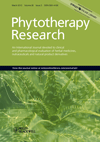Quercetin 3-rhamnoside Exerts Antiinfluenza A Virus Activity in Mice
Abstract
Our previous report showed that quercetin 3-rhamnoside (Q3R) possessed antiviral activity against influenza A/WS/33 virus in vitro. The present study evaluated the effect of Q3R on influenza A/WS/33 virus infected mice. Mice orally treated with Q3R (6.25 mg/kg per dose) at 2 h before and once daily for 6 days after influenza virus infection showed significant decreases in weight loss, and decreased mortality. Lung virus titers of mice killed at 6 days after infection were about 2000 times lower than that of the placebo-treated control mice and about two times lower than that for the oseltamivir-treated mice. Furthermore, histological evaluation showed that administration of Q3R delayed the development and progression of pulmonary lesions. Therefore, Q3R could be an attractive lead for the development of antiviral agents against influenza virus. Copyright © 2011 John Wiley & Sons, Ltd.




